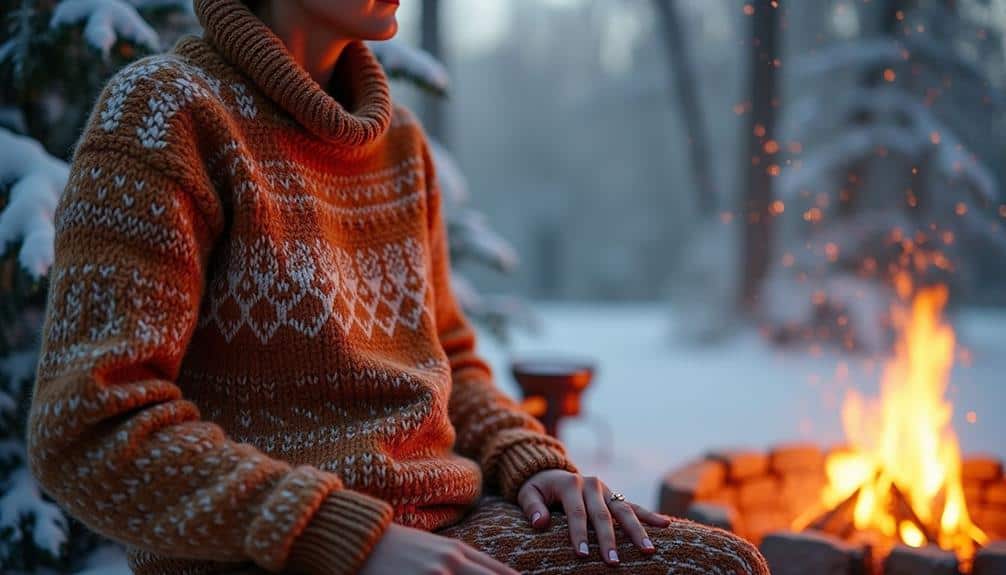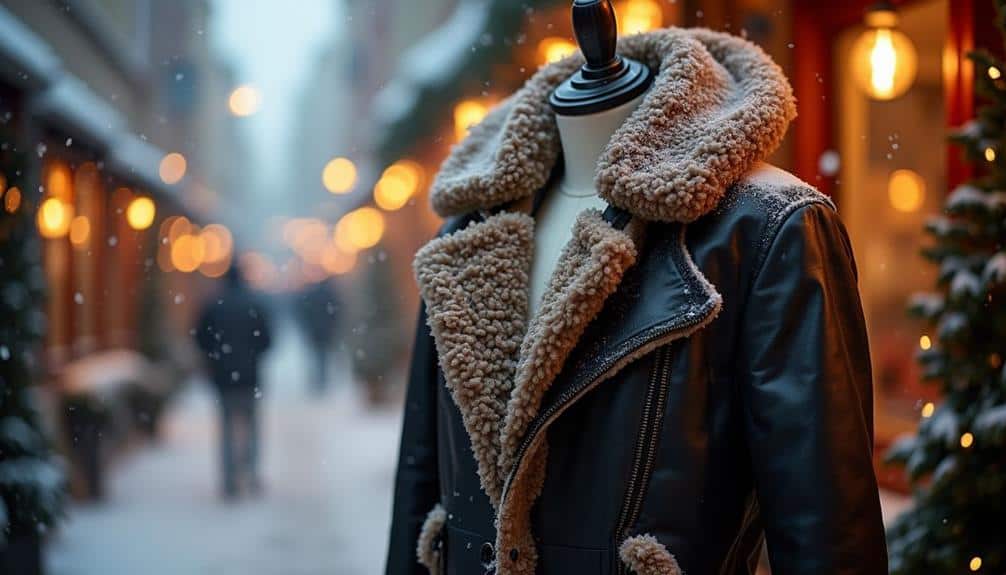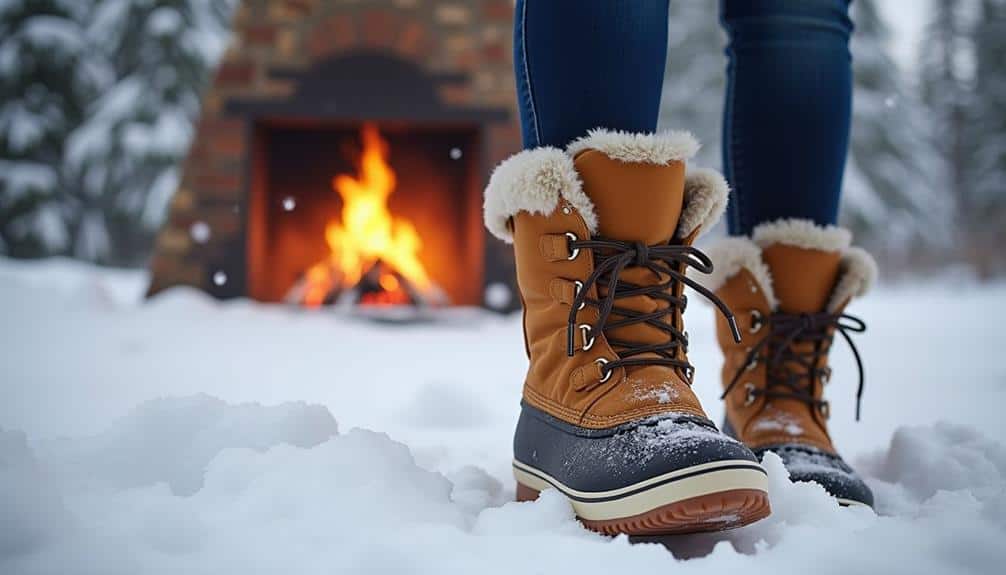As the Russian winter approaches, mastering the art of staying warm while maintaining a stylish appearance becomes paramount. The choice of materials such as wool, down, and fleece plays a critical role in providing the necessary insulation and moisture control. Essential clothing items like puffer jackets, thermal base layers, and insulated pants are designed to be layered for maximum warmth. Equally important are accessories like scarves, hats, and gloves, which not only enhance one’s outfit but also offer indispensable protection against the severe cold. So, what specific materials and layering techniques should you consider to brave the Russian winter with both comfort and style?
Woolen Sweaters

Woolen sweaters, often made from high-quality merino or alpaca wool, are a quintessential component of winter wardrobes in Russia. These garments are prized not only for their warmth but also for their ability to balance comfort and style.
Merino wool, renowned for its fine fibers, offers exceptional insulation while remaining lightweight and breathable. This makes it a superior choice for enduring the harsh Russian winters without feeling bulky.
Cable knit patterns, a popular design in woolen sweaters, add both aesthetic appeal and functional benefits. The intricate weaving of cable knit provides additional layers of insulation by trapping air between the fibers, enhancing the sweater’s thermal efficiency. This design is particularly favored in Russia, where temperatures can plummet to extreme lows, requiring reliable and efficient winter wear.
Moreover, the durability of merino wool guarantees that these sweaters maintain their shape and softness through years of use, making them a sustainable choice.
Whether layered under a coat for outdoor activities or worn alone indoors, woolen sweaters are indispensable for anyone seeking both warmth and elegance during the frigid Russian winters. Investing in high-quality woolen sweaters is a pragmatic and stylish approach to winter attire.
Thermal Fabrics
When it comes to combating the relentless cold of Russian winters, thermal fabrics stand out as an essential choice for effective insulation and comfort. These advanced textiles are designed to trap body heat, providing superior thermal insulation benefits that are vital in sub-zero temperatures.
The primary function of thermal fabrics is to create a barrier against the cold, ensuring that warmth is retained close to the skin. This makes them indispensable for layering, which is a fundamental strategy for staying warm during harsh winters.
An important feature of thermal fabrics is their moisture wicking properties. Unlike traditional materials, thermal fabrics are engineered to draw moisture away from the body, thereby keeping the wearer dry and preventing the chill that can result from perspiration.
This moisture management is particularly beneficial during physical activities such as skiing, hiking, or even daily commutes in frigid weather.
Moreover, thermal fabrics are available in a variety of weights and finishes, allowing for versatility in clothing design. Whether incorporated into base layers, leggings, or thermal tops, these fabrics enhance comfort without sacrificing style.
Their ability to combine functionality with modern aesthetics makes thermal fabrics an ideal choice for enduring the extreme conditions of Russian winters.
Fur-Lined Coats

While thermal fabrics provide an excellent foundation for layering, fur-lined coats offer an unparalleled level of warmth and luxury that is particularly well-suited for Russian winters. These coats are especially effective in retaining body heat, thereby providing an essential barrier against the harsh, frigid winds that characterize the season. The presence of fur lining not only adds a touch of opulence but also considerably enhances thermal insulation.
When choosing a fur-lined coat, it is imperative to take into account fur care. Proper maintenance is essential to guarantee longevity and sustained performance. Regular cleaning and professional storage during off-seasons can prevent the fur from matting and deteriorating. Additionally, brushing the fur and keeping it dry are crucial steps in preserving its natural luster and insulation properties.
Equally important is the aspect of ethical sourcing. Consumers today are increasingly aware of the environmental and ethical implications of their purchases. Opting for fur-lined coats from brands that adhere to ethical sourcing standards guarantees that the fur is obtained through humane and sustainable practices.
This not only supports responsible fashion but also aligns with the growing trend towards conscious consumerism. To summarize, fur-lined coats provide an exquisite blend of function and fashion, making them an indispensable choice for enduring Russian winters.
Layering Techniques
Layering techniques are fundamental for maximizing warmth and comfort during Russian winters. Effective layering principles help in maintaining body heat, ensuring flexibility, and providing moisture management.
The foundation of any layering system starts with base layers. These are typically made from materials like merino wool or synthetic fabrics that excel at wicking moisture away from the skin, thereby keeping you dry and warm.
The second layer, often referred to as the insulating layer, is designed to trap body heat. This can be achieved through garments such as fleece jackets or down vests, which create air pockets that retain warmth. The effectiveness of this layer is contingent upon the quality and type of insulating material used.
The final layer, known as the outer layer or shell, serves as a protective barrier against wind, snow, and rain. Ideally, this layer should be both waterproof and breathable to prevent external moisture from seeping in while allowing internal moisture to escape.
High-quality options include Gore-Tex jackets or other technical outerwear.
Insulated Footwear

Insulated footwear is an indispensable component of winter attire, particularly in the harsh and frigid conditions of Russian winters. The significance of insulated boots cannot be overstated, as they provide the necessary warmth and protection from the extreme cold.
High-quality insulated boots are typically designed with advanced thermal insulation technologies, such as Thinsulate or PrimaLoft, which offer superior heat retention without adding bulk.
An additional important feature to take into account is the use of waterproof materials. Russian winters often bring not only snow but also slushy and wet conditions.
Footwear constructed with waterproof materials like Gore-Tex or rubberized coatings guarantees that feet remain dry, thereby preventing frostbite and other cold-related ailments. Waterproofing also enhances the durability of the boots, making them a long-term investment for enduring multiple winters.
Furthermore, insulated boots should offer a robust sole with excellent traction to navigate icy and slippery surfaces safely.
The combination of thermal insulation, waterproof materials, and a sturdy sole guarantees that one can traverse the winter landscape with confidence and comfort.
Selecting the right insulated footwear is an essential step in maintaining warmth and style during the unforgiving Russian winters.
Accessories for Warmth
Accessories for warmth play an indispensable role in guaranteeing comfort and protection during Russian winters. As temperatures plummet, selecting the right accessories becomes vital.
Scarves, for instance, are indispensable for retaining body heat and shielding the neck from icy winds. Various scarf styles, such as woolen, knitted, or cashmere, offer both functionality and fashion. Woolen scarves provide excellent insulation, while cashmere options add a touch of luxury and softness. Knitted scarves, often handcrafted, offer unique patterns and textures, catering to individual tastes.
Equally important are hats, which prevent significant heat loss from the head. Hat options are vast, ranging from traditional ushankas, which are fur-lined and cover the ears, to modern beanies and trapper hats. Ushankas, made from materials like sheepskin or rabbit fur, provide unmatched warmth and are a quintessential Russian winter accessory.
Beanies, typically made from wool or synthetic fibers, offer a snug fit and are available in various designs. Trapper hats, with their ear flaps and chin straps, offer a blend of style and practicality.
Incorporating these accessories into your winter wardrobe guarantees a balance of warmth, comfort, and style, vital for braving the harsh Russian climate.




